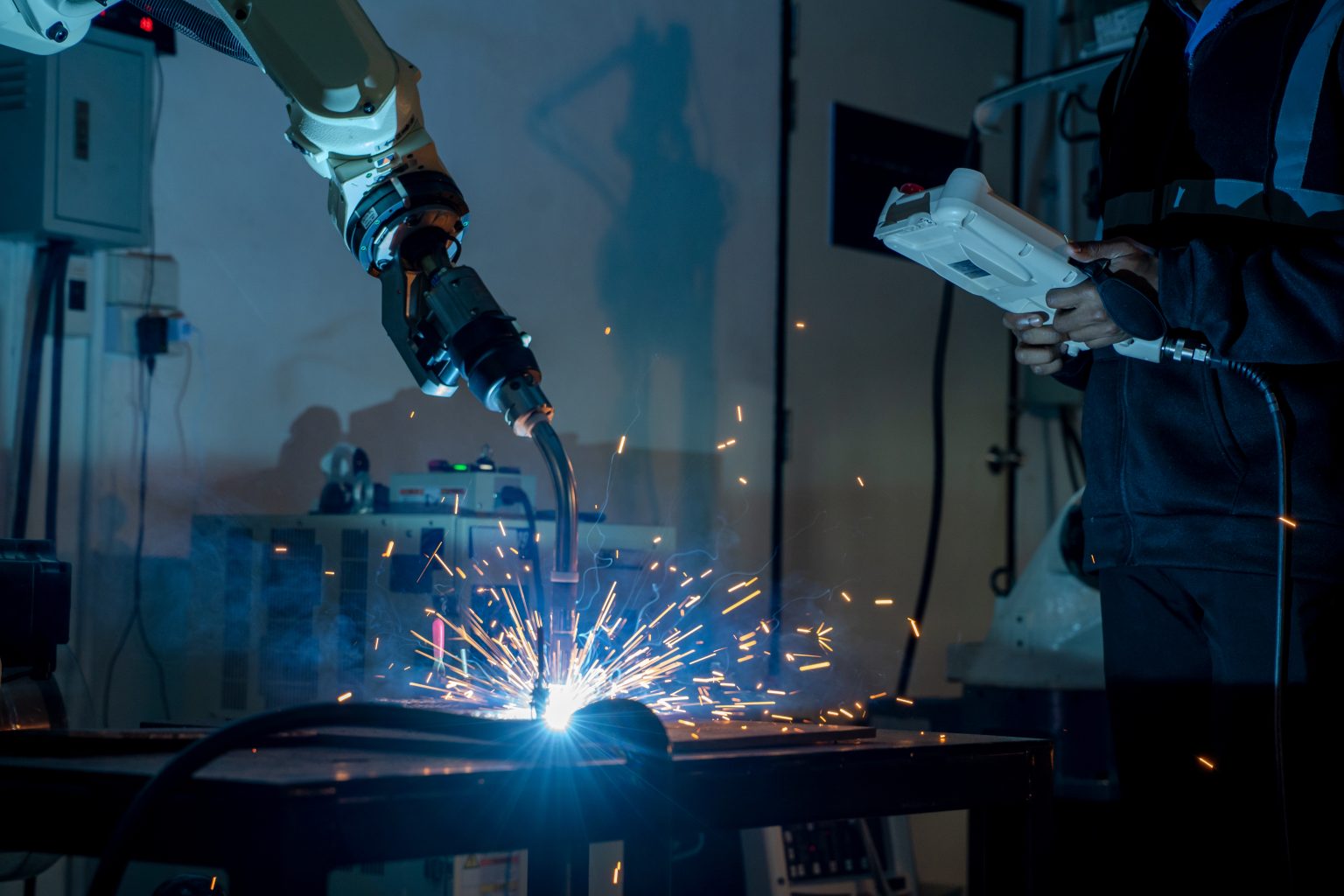What is Robotic Welding?
Robotic welding is revolutionizing the manufacturing industry by delivering enhanced precision and efficiency with the help of automated robots. The torch operation time of arc welding performed by human welders is less than that of robotic welding with greater productivity rates. Automation means fewer mistakes, which creates steady weld outcomes and decreased material loss. Robotics engineers assess PUMA-type and UR-type arms to determine their peak welding capabilities, considering space requirements and collision avoidance.
Robotic systems become more adaptable when they include operator skill modeling, which lets them produce welding techniques that had only been possible through skilled human operators. Automation advances welding operations through the combination of human expertise with robotic precision, which establishes new manufacturing benchmarks and boosts performance.
How Does Robotic Welding Work?
Components and Functionality of Robotic Welding Systems
Robotic systems for welding require multiple essential parts that allow precise automation of welding operations. The main component is the robotic manipulator, which consists of a six-axis articulated arm that enables dexterity to execute weld paths. The welding torch operates from this arm to deliver both the welding arc and filler material. The power supply unit functions as the vital component that controls electrical values to guarantee stable arcs and high-quality welds. A wire feeder regulates the material flow for constant dimensions of weld deposition. New welding systems include sensors alongside cameras for real-time monitoring, which permits automatic process modifications throughout the welding operation. The central controller coordinates all system components and interprets commands to ensure seamless welding operations.
Achieving Efficiency and Precision in Robotic Welding
Continuous operation and precise control of welding parameters enable robotic welding systems to produce efficient, high-precision outcomes. Robotics outperforms human welders since they can operate around the clock, which results in increased productivity. Weld precision is possible because robots can use programmed variable control to determine travel speed, arc length, and heat input, therefore creating welds with precise tolerances measured in millimeter fractions. Robotic seam tracking has real-time sensors that make dynamic tweaks to material compensation, so quality welds are consistent. The ability of robots extends to reaching difficult welding positions and keeping ideal torch angles, which avoids porosity and incomplete fusion.
Advantages of Welding Robots
Increased Productivity and Efficiency
Robotics-based welding outperforms manual welding in terms of production efficiency through its extended span of arc time delivery. Human welders operate their equipment 10-30% of the time, but robotic systems handle jobs between 50-80% in non-serial production and 90% in serial production. A robotic cell operating as a welder can replace up to five human welding employees. General Motors obtained a 30% boost in productivity together with a 20% decrease in operational costs through their adoption of robotic welding for assembly lines. Robotic welding systems function without interruptions, which improves production time and throughput.
Consistent Quality and Precision
Robotics systems for welding produce precision while guaranteeing repetitive performance that creates welds with high consistency and low amounts of imperfections. The robotic welding system executes welds with total accuracy, which eliminates manufacturing variation and provides better-quality products. Fendt has accomplished both 25% less production expenses and 15% faster manufacturing speed because robotic welding delivers consistent weld quality. Real-time signature image processing provides industrial facilities with the ability to detect welding faults during production, which lowers defects and delivers high-quality welds.
Reduction in Waste and Consumable Usage
The precise control of welding parameters through robotic welding systems lets industries attain maximum material efficiency and minimum consumable consumption. Robots use the exact amount of material for each weld while avoiding over-welding and lowering spatter, which might be common in manual processes. The exact nature of robotic welding operations saves costs on materials and consumables. Robot-based welding at New Holland Agriculture resulted in a 22% decrease in material waste. The consistent weld quality from robotic welding diminishes necessary rework, which generates extra material savings and working efficiency.
Key Tasks of a Robotic Welder
Spot Welding
Automobile body assembly needs robotic spot welding as a key manufacturing method. The joining process of overlapping metal sheets depends on robots delivering accurate pressure and electrical currents through copper electrodes. A car body would need numerous spot welds, yet robotic systems carry out this work reliably to lower manufacturing time and work expenses.
Arc Welding
A robotic arc welder reaches fusion temperatures of 6,500°F through its electric arc functionality. Heavy manufacturing industries depend on this procedure to build pipelines and structural components. Robotic arc welding systems deliver deep penetration welds and uniform quality to shipbuilding structures because such features confirm vessel structural integrity.
TIG and MIG Welding
Robotics systems can perform two precision metal welding operations known as TIG (Gas Tungsten Arc Welding) and MIG (Gas Metal Arc Welding). The aerospace industry chooses robotic TIG welding to generate exceptional welds on thin aluminum and titanium materials. On the other hand, MIG welding robots with their continuous wire feed system dominate steel construction because they deliver high efficiency rates and intense welding speeds.
Laser Welding
Robotic laser welding glue cells together using a strong laser beam to create quick, precise welds that decrease heat-related distortion. The technique proves advantageous in the electronics industry because delicate components demand exacting welds. Robotic laser welding forms strong connections between battery cells in a manner that protects sensitive components.
Plasma Welding
Deep penetration alongside narrow welds becomes possible through robotic plasma arc welding thanks to its high energy density capabilities. The method finds applications in businesses that need outstanding stainless steel and alloy welds. Robotic plasma welding systems empower the production of medical devices that result in strong sterile joints guaranteeing patient security.
Looking to boost efficiency and weld quality? Add a robotic welding solution to your production line.

